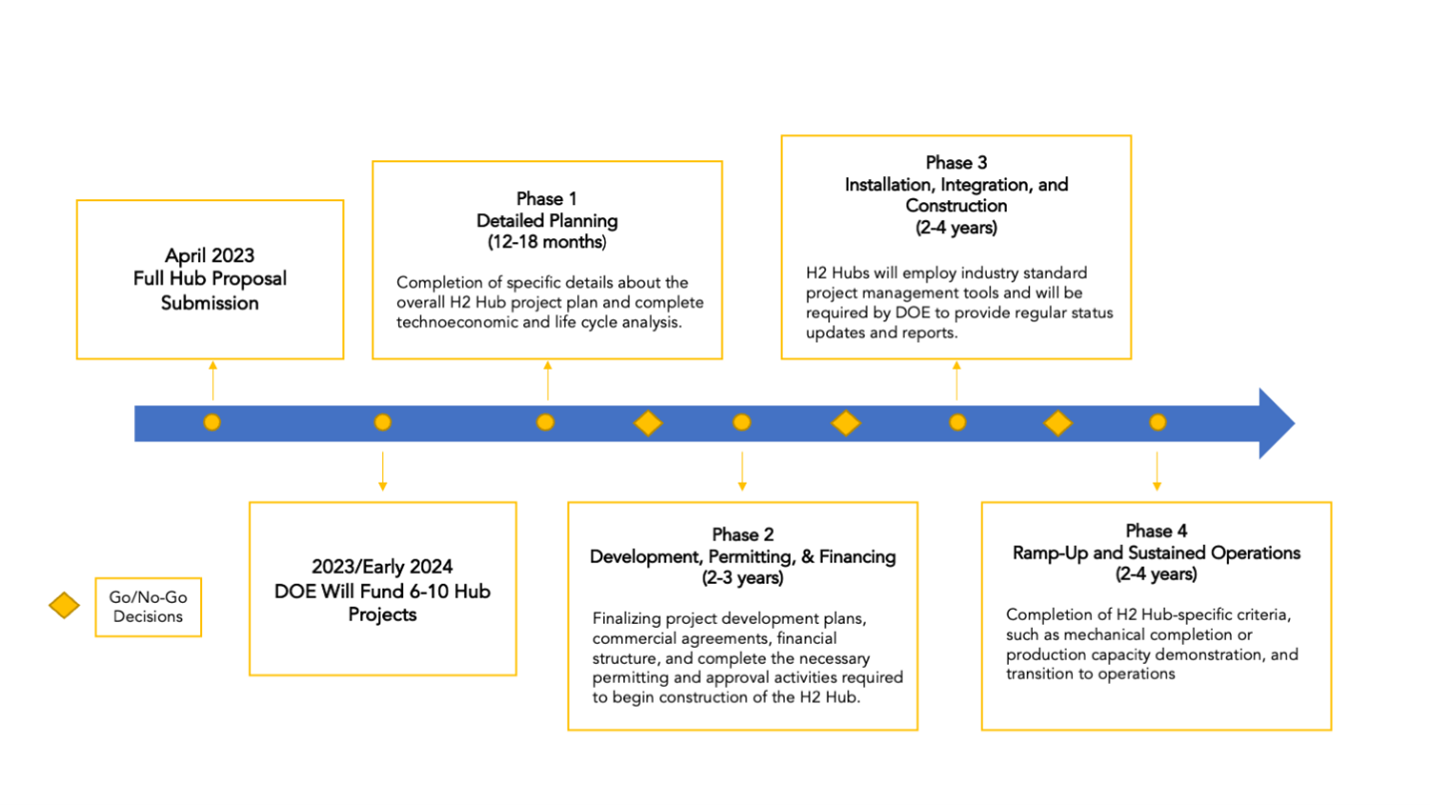 By Jona Koka
By Jona Koka
The Department of Energy’s $7 billion hydrogen (H2) and $3.5 billion direct air capture hubs program has been hailed as an opportunity to unleash innovation and create a new vision for industrial development. We’ve written about it before and agree this is a great opportunity to set a much higher bar for what high-quality projects could look like, including strong environmental protections and much deeper and more authentic partnership with communities.
But Environmental Defense Fund has been asked several times: How does this really work? What are the timelines? And how can I make my voice heard in the process?
For easy access, we’ve pulled together all the information in one place.
The application timeline
The application deadline closed on April 7, 2023, but there are still multiple steps ahead:
- Application review (now until late summer/early fall 2023): Applications are reviewed and rated on a series of criteria, including a 20% grading based on community benefits. Applications will be reviewed by DOE and by “Merit Reviewers” — external reviewers who have expertise in aspects of project development, community benefits or other relevant areas.
- Selection (summer/early fall 2023): DOE selects projects, essentially identifying the winning proposals.
- Award negotiation (from selection until late 2023/early 2024): Selected projects will take part in award negotiations with DOE, in which they negotiate the terms of the grant with DOE, finalize the community benefits plan and finalize other details.
- Conclusion (likely early 2024): Upon assigning awards, DOE is expected to make public the list of winners and a summary of each project selected.
What happens once hubs are funded?
Once the projects are awarded, DOE plans to fund the H2 and DAC hubs in four phases with what are known as go/no-go decisions (discussed in more detail below). This means DOE has the power to require additional engagement or end the grant if the project is not living up to its commitments. Or, in DOE’s words, “DOE or its representatives may be deployed, and corrective measurements negotiated;” and hubs, or portions of a hub, “may be discontinued at any of the go/no-go points.”
This framework was designed to incentivize continued high performance against objectives and provides ongoing opportunities for stakeholders and communities to engage and have meaningful impact in each phase of the hub process.
Transparency, authentic engagement and meaningful collaboration throughout the hub development process will be key to ensuring these projects meet or exceed expectations for the climate, environment and communities.
Beyond the application: what’s next for DOE’s hydrogen and direct air capture hubs, and how to engage in the process Share on XWhat are the phases for hub planning, development and construction?
The H2 and DAC hubs will be developed over an eight-to-twelve-year time frame. The image below shows the current DOE timeline for H2 hubs. DAC timelines will be similar.
- Phase one, Hub Design and Planning, will be the shortest phase, lasting only 12-18 months. The work done in Phase one focuses on getting all the details of the proposed hub on paper.
- Phases two (Development), three (Construction), and four (Operation and Expansion) will each last approximately two-to-four years, depending on the individual hub.
- Phase two will focus on finalizing the hub development plan, commercial agreements, financial structure, and completing the necessary permitting and approval activities required to begin construction.
- Phase three, which DOE envisions will be the longest, will be the physical construction of the hub.
- Phase four will focus on sustained operation
 The H2 hubs will have three go/no-go decisions one after each phase, and the DAC hubs will have go/no-go decisions after Phase one and Phase three. Specific go/no-go criteria will be negotiated between DOE and the Hub development with each selected hub project for transition between the phases. DOE has stated that it will require access to unfettered project performance and financial data in order to track progress for go/no-go decisions and that, to the greatest extent possible, project progress and information will be shared with interested stakeholders. DOE has not stated if it will seek stakeholder input during the go/no-go decision-making process, but program teams have emphasized in both private and external communications they welcome feedback from communities.
The H2 hubs will have three go/no-go decisions one after each phase, and the DAC hubs will have go/no-go decisions after Phase one and Phase three. Specific go/no-go criteria will be negotiated between DOE and the Hub development with each selected hub project for transition between the phases. DOE has stated that it will require access to unfettered project performance and financial data in order to track progress for go/no-go decisions and that, to the greatest extent possible, project progress and information will be shared with interested stakeholders. DOE has not stated if it will seek stakeholder input during the go/no-go decision-making process, but program teams have emphasized in both private and external communications they welcome feedback from communities.
How is community engagement treated in these programs?
Community engagement is required in all phases. In the application, proposed hubs had to submit initial community engagement plans and letters of support and are required to implement those plans in each phase and provide metrics on their implementation to DOE. Hub developers are encouraged by DOE’s Community Engagement Plan Guidance — the first document of its kind at DOE — to have public hearings, town hall meetings, open houses, one-on-one meetings and virtual workshops, among others, during all four phases. Communities can use these forums to ask questions, gather information and provide feedback to the developers. The first two phases will most likely have the most community outreach, as hubs are still in the design and development phase.During Development (Phase two) and Construction (Phase three), hubs will also be required to get state and local permits and complete environmental assessments. These permitting phases will provide additional opportunities for public comment and engagement at multiple jurisdictional levels, and likely with a variety of oversight agencies. For more information on hub phases please see FOAs for H2 and DAC hubs.The FOA/timeline/guidance lays out a vision for continuous engagement throughout, which is intended to create a scenario where information is shared, input is heard and thoughtful project adjustments or modifications are made in response. DOE has emphasized that this program is not intended to allow for a check the box exercise in which community feedback is sought in a cursory, selective or otherwise ineffective way, but one that requires accountability and authentic engagement.
How can I engage?
Applications are submitted and DOE is now actively reviewing them. As noted above, applications will be evaluated against technical merit review criteria, and the “community benefits plan” is worth 20% of the overall score. These H2 and DAC hubs will be first-of-their-kind projects, which means there are no set guidelines on how they can be best developed. Success will require input from all those involved and impacted to help shape them into positive demonstrations. Here are some ways you can engage now:
- Participate as a merit reviewer: DOE is looking for a diverse pool of individuals to review the Community Benefit Plans sections (i.e., diversity, equity, inclusion, and accessibility environmental justice & Justice40; quality jobs; and community engagement) and is inviting individuals with expertise in these areas to apply to serve as reviewers. This is one of the most important actions interested parties can take now to make sure the proposed community benefits plans have been thoughtfully designed. You can register with the Office of Clean Energy Demonstrations, which will fund both hubs, to become a reviewer.
- Engage with developers, and/or DOE, to share your expertise and priorities. During this review phase, project proponents should continue to be diligent in sharing information and asking questions from the public. Though DOE is limited in its ability to directly reach out to communities during procurement processes, interested parties should still feel empowered to directly reach out to OCED to share information and local lived-experience-based perspectives on particular hubs.
More transparency, please.
DOE has taken many positive steps to ensure the success of H2 and DAC hubs. But there is still more work ahead. We are at a pivotal point in what could be an industrial decarbonization revolution. How successful this revolution will be, however, will depend on how these first projects are executed. Together, we must all ensure these projects are truly planned and executed differently.
One of the ways DOE and hub developers can help foster this paradigm shift is by committing to transparency in all phases of the hub development. At the moment, they are failing. Because DOE has kept all applicant data confidential, there are few public details about the applicants and their proposed projects. What little information we have learned comes from press releases and media stories, usually in which applicants self-announce their activity. There are no risk opportunities — like simply sharing a list of hub applicants or redacted concept papers — that would keep the public from feeling completely in the dark without disclosing proprietary or confidential business information.
DOE and hubs not only need to be transparent, but they must also be committed to providing real, substantive information to the local communities where they will be developed. For communities to partake in meaningful engagement, they must have access to relevant information. If “community benefit plans” move forward without real transparency and authentic outreach, dialogue and collaboration, they will be “benefit plans” in name only and result in no meaningful change from how industrial development occurred in the past. DOE and project proponents should work diligently to ensure this does not happen.
Building BetterHubs
Developing industrial hubs that center the environment and communities alongside corporate and climate goals is no easy task. As EDF’s initial effort to engage, we developed a resource called BetterHubs, a tool that identifies 10 key objectives with rigorous environmental and social metrics intended to help set a higher bar for strong, equitable and fair Hub proposals and projects. BetterHubs is intended to help regulators, developers, investors and community stakeholders identify and consider how specific Hub proposals are addressing the key challenges. We know that if these projects have any chance to succeed, the framework and information must be available to help stakeholders and decision-makers across the value chain work collaboratively and proactively to design and engage with industrial hub projects in ways that are transparent, accountable and result in better outcomes for both people and the planet.
Project applications are in, but it’s only Step one in a very long journey to visible outcomes and results. EDF is committed to doing what we can to bring accountability and transparency to this process that fosters positive momentum and looks forward to the opportunity to collaborate with others throughout this multi-phase process toward making that a reality.









